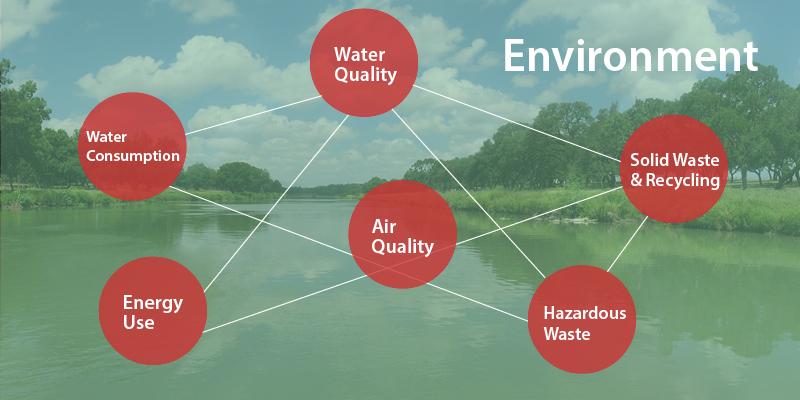Environment

In its original form, sustainability was closely associated with the maintenance of environmental quality. The roots of a sustainability paradigm grew from a concern of the ability of the earth to sustain a growing human population, known as carrying capacity. The same can be said for our region. As the Austin area experiences an unprecedented population boom, the demand on natural resources that sustain life is significant and sustainability is intricately linked to the environmental quality of the region as a whole. Environmental sustainability is interdependent with quality of life and connected to outcomes in many of the other indicator areas. Questions of economy, mobility, or any other sustainability dimension are unnecessary if not situated in the context of a healthy and thriving natural environment. Some key indicators for this section include: water consumption and water quality; energy use; air quality; solid waste disposal and recycling; hazardous waste; and regional air quality and climate change.
Key Indicators
Water Demand
Municipal demand for water is dramatically greater than all other uses combined. The combination of population growth and changing climatic patterns is potentially problematic for the Austin Area. By 2030, municipal demand is expected to double to service a projected population of three million residents.
Watershed Capacity
Thanks to greater rainfall, the highland lakes supported by the Colorado River and tributary watersheds, are at or near 100% capacity. This is the primary source of water in the Austin area, except for Bastrop County.
Public Perception of Climate Change
A significantly larger portion of residents, 32%, responded with a 10 to the question: “On a scale of 1-10, how concerned are you about climate change?” This is a 10% increase from 2015 and nearly double from 2010. The percentage of people that answered with a 1 remained roughly the same, 11%, as compared to 2015. The data in Figure 10 shows a clear trends of increasing concern.
Access to Green Space
Nearly one in five (21%) of Austin Area residents report visiting or passing through outdoor greenspace 6-7 days a week. However, the geographical distribution of greenspace and access to greenspace is not equal. Twenty-five percent of black residents report not having access to nature or greenspace in their neighborhood as compared to 8% of white residents.
Renewable Energy
Austin Energy has increased its capacity of providing renewable energy over the years from 0.6 million Mega-Watt Hours in 2006 to 3.54 million Mega-Watt Hours in 2017, an increase of about 590%. Furthermore, in 2017, Round Rock became one of the few cities in the U.S. to run 100% on renewable energy.
Public Perception of Water Issues
According to the 2018 A2SI Community Survey, the percentage of Austin area residents who know where their household water comes from is 75.3%. An increase of abour 30 percentage points from previous years.

